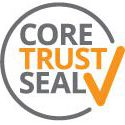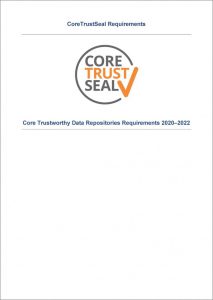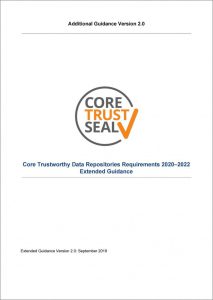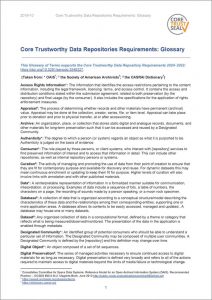Addendum (27 October 2020): An updated (Version 2.0) of the Report of the CoreTrustSeal Review 2019 Working Group is now available and includes changes to the Extended Guidance 2020–2022. Moreover, a file showing the changes between the Extended Guidance for 2017–2019 and 2020–2022 has been published on Zenodo: https://zenodo.org/record/3828636.
Final update (06 February 2020): The CoreTrustSeal Trustworthy Data Repositories Requirements 2020–2022, its Introduction, Extended Guidance, and Glossary have now been published on Zenodo and may be found on the Data Repositories Requirements page.
[Note: Submission date for applications updated on 09/09/2019 to ensure clarity.]
A message to the CoreTrustSeal community:
A review of the CoreTrustSeal will take place in 2019 to define the Requirements for the period 2020–2022. This has no impact on the certifications of current CoreTrustSeal-certified repositories, which continue to run for three years from the date awarded.
The 2019 review process will focus on applicant feedback received during past reviews, other feedback received during communications and outreach activities, and an open review period to run from 1 March 2019 to 30 April 2019 31 May 2019. Given the feedback received to date and the fact that a number of past WDS and DSA repositories are continuing to transition to the CoreTrustSeal Requirements, we expect the number, structure, and content of the Requirements to remain fundamentally stable for 2020–2022. This stability will enable us to work to support a wider range of repository types and repository technical infrastructure providers in the future. It will also provide an established baseline from which to consider other external demands on the CoreTrustSeal, including the development of the European Open Science Cloud and the further clarification of FAIR Data Principles.
Feedback will be incorporated into revisions of the Requirements, Extended Guidance, and Glossary as necessary.
A draft revision of the CoreTrustSeal Requirements will be made available by 31 July 2019 for comment and a final version will be released by 31 October 2019.
Applications and renewals against the current version of the Requirements are asked to submit by before 1 November 2019 (i.e., by 23:59 on 31 October 2019) to minimize the number of reviews that overlap different versions of the Requirements. Applications against the revised requirements will be accepted from 1 January 2020.
The CoreTrustSeal Board (22 February 2019)
Update (6 August 2019): Responses to feedback received & draft CoreTrustSeal Requirements 2020–2022
Thank you again to everyone for your valuable feedback given both during the open review period and within the application process. A subcommittee of the CoreTrustSeal Board met face-to-face in DANS (Den Haag, Netherlands) on 23–25 July to discuss every comment in turn, and to decide on what revision (if any) should be made to the CoreTrustSeal certification standard either now or in the future. After examining all of the comments, the subcommittee then updated the Core Trustworthy Data Repositories Requirements, in particular the Guidance text for each Requirement, according to proposed revisions.
The first draft of the Requirements for 2020–2022, as well as a change file highlighting the revisions, may be accessed by clicking on the below links (both PDF):
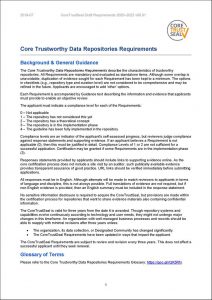
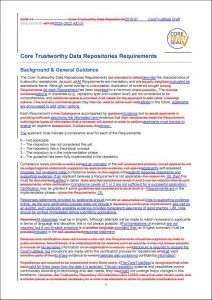
Draft Requirements 2020–2022 Change file 2017–2019 to 2020–2022
The response given by the CoreTrustSeal Board to each piece of feedback is given in the below GSheet. If you are unable to access Google, then you may download a PDF version of the spreadsheet here:
Note that work was also started on updating the Extended Guidance and the Glossary, and draft versions of these documents will be shared on this page in the coming days.
Recognizing that the open review period is closed for the 2019 review, and thus requests for comprehensive changes will be rejected, please send any thoughts you have on the draft documents to 2019review@coretrustseal.org by 30 September 2019. [Note 20/11/2019: The comment period is closed and the email address is now deactivated.]
Click here to access the full GSheet.
Update (4 September 2019): Report of 2019 CoreTrustSeal Review
We apologize for the delay, but we are now in a position to share the Report of the CoreTrustSeal Review 2019 Working Group (Version 1.0) [PDF]. This report gives more information on the evaluation/decision process undertaken by the subcommittee of the CoreTrustSeal Board charged with leading the 2019 periodic review of the Core Trustworthy Data Repository Requirements. It details the exact updates made to the CoreTrustSeal documentation for 2020–2022, as well as the current thinking for a more extensive review and revision of the Requirements in 2021/2022.
Update (20 November 2019): Final CoreTrustSeal Requirements 2020–2022, Extended Guidance, and Glossary
We must once again apologize for the very long time this has taken, but are delighted to finally be able to publish the final version of the CoreTrustSeal Requirements 2020–2022, the accompanying CoreTrustSeal Extended Guidance 2.0, and the updated Glossary. You may access each of them using the links below. When doing so, please note the following:
- The final version of the Requirements has only very minimal changes from that released in August 2019.
- The Extended Guidance is a living document that will be enhanced over time according to the experiences of applicants and reviewers. In this regard, if you have any comments on the document, then please contact the Secretariat.
- We expect the Glossary to remain unchanged throughout 2020–2022. However, we recognize the need for the community to provide feedback. Please send the Secretariat any thoughts on the Glossary by Friday, 20 December using our contact form so that we can include changes for 1 January 2020. [Note 21/12/2019: The comment period is closed.]
- The DOI in the Glossary is reserved, but not published, pending any last-minute changes to the documents.
